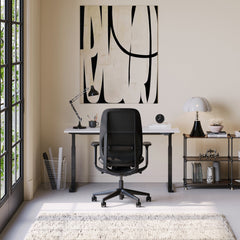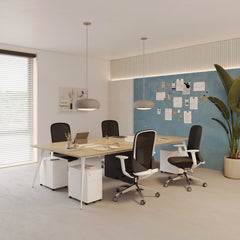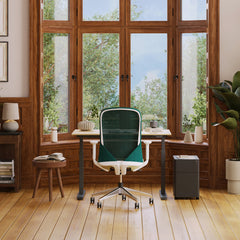Get 10% off your first order
Find the office furniture that’s designed to match your style, comfort, and needs perfectly. Subscribe
Beyond Desks and Chairs: How Cohesive Design Shapes Your Office Brand

Visit quiz page to see how we makes it easy to create an inspiring workplace


Today's changing corporate climate has transformed the physical workspace into a vital instrument for productivity, collaboration, and employee well-being. It silently boosts or hinders team performance. Instead of additional meetings or tighter deadlines, your team may need a careful environment makeover to establish its rhythm.
This revolution is about intentional design based on human psychology and ergonomic science, not excessive spending or current gimmicks. We are studying how to create an office environment that naturally encourages deep work, reduces friction, and inspires collaborative focus that turns outstanding ideas into amazing results. A focused workstation helps the individual and strengthens teamwork.
Constant interruptions can be mentally taxing. Research suggests that it can take up to 23 minutes to regain focus after a break. Teams' "attention residue" multiplies, resulting in constant fragmented production. We boost productivity and focus by creating distraction-free settings. We progress from bustle to purposeful output.
Modern workers spend most of their time at work. The brain wastes energy on stresses including physical discomfort, audio disruption, and visual startling instead of solving complicated issues. Continuous low-level irritation causes burnout, decreased creativity, and greater error rates. By investing in the workspace, you invest in your best assets' brainpower. Creating an environment where the path of least resistance leads to concentrated achievement.
The colors and illumination in a workspace profoundly impact mood, alertness, and cognitive function. This is not interior decorating; it is neuroscience. Understanding the psychological effects of your environment is the foundation of an inspiring space.
Different colors trigger different responses:
Blues and Greens: Often associated with nature, these colors promote calmness and stability, making them excellent choices for spaces requiring deep concentration. They reduce anxiety and enhance creativity.
Yellows and Oranges: Used sparingly, these can evoke energy and optimism. They are effective in brainstorming or communal areas but can be overstimulating in individual focus zones.
Neutrals (Grays, Whites, Beiges): These provide a quiet backdrop, reducing visual clutter and allowing the team's work to be the central focus. They are the backbone of a visually calm and uncluttered environment.
Lighting is perhaps the most underrated element. Harsh, uniform fluorescent light can cause headaches and fatigue, while poor lighting leads to eye strain. The quality and type of light signal to the brain how active it should be.
Natural Light Priority: Maximize access to natural light. It regulates the circadian rhythm, boosts mood, and has been directly linked to improved cognitive performance and better sleep quality outside of work. If direct natural light is scarce, use full-spectrum LED bulbs that mimic sunlight's color temperature and intensity shifts throughout the day.
Layered Lighting: Implement ambient (general overhead), task (desk lamps for specific work), and accent lighting (to highlight features). This allows individuals to customize their light levels, which is crucial for comfort and focus. Task lighting is especially important for detail-oriented work, as it eliminates shadows and reduces eye strain.
Dimmability: Incorporate dimmable lights in certain zones, giving teams the control to adjust brightness based on the task, whether it is a low-light presentation or intense reading.
An uncomfortable employee is a distracted employee. Ergonomics is not a luxury; it is a necessity for sustained focus. It is about fitting the environment to the human, not the other way around. When physical discomfort is removed, mental energy can be entirely dedicated to the task at hand. Poor posture and static sitting are known culprits for energy drain and mid-afternoon slumps.
The core principle here is movement and adaptability. No single posture is ideal for an entire workday. The best setup is one that encourages regular, subtle shifts in position, ensuring blood flow and minimizing muscle fatigue.
|
Component |
Focus Benefit |
Ergonomic Solution |
|
Seating |
Posture support, reduced fatigue, spine alignment. |
Fully adjustable chairs with lumbar support and waterfall seat edges. The chair should move with the body. |
|
Desk Height |
Encourages movement, aids circulation, revitalizes energy. |
Providing Adjustable Height Work Surfaces allows fluid transitions between sitting and standing throughout the day, mitigating the risks associated with prolonged static posture. |
|
Monitors |
Reduced neck strain, visual comfort, maintained line of sight. |
Adjustable arms to place the top of the screen at or slightly below eye level, and an arm's length away. |
Providing a range of work styles, from individual deep focus to collaborative sessions, means equipping the office with varied furniture. For teams looking for quality and reliability, ensuring you have the ability to switch between sitting and standing enables employees to tailor their workspace to their body's needs throughout the day. This simple yet profound change can dramatically increase energy levels and concentration, moving employees from passive to active work.
A truly adaptive environment acknowledges that different tasks require different levels of physical engagement. A phone call might be best taken standing or walking, while complex coding demands a supported, seated posture. This flexibility is a core tenet of modern, focus-driven office design.
Noise is one of the most significant destroyers of team focus. It is not just the volume, but the type of noise. Unpredictable, conversational noise is far more distracting than steady background sounds. The brain is hardwired to process human speech, making overheard conversations highly disruptive. The goal is not silence, but control over the soundscape to enhance concentration.
The human brain can filter ambient sounds, but it struggles intensely with verbal distraction. Every time a word is overheard, the brain momentarily pauses its primary task to process the speech, leading to loss of momentum and focus.
Sound Masking Systems: These systems introduce low-level, ambient background noise (often a gentle rush of air or white noise) that covers up the intelligibility of nearby conversations, making them less distracting. This raises the overall noise floor subtly.
Acoustic Paneling and Textiles: Install sound-absorbing panels on walls and ceilings, especially in open-plan areas and meeting rooms. Fabric, felt, and specially designed foam panels absorb sound waves, preventing echo and reverberation. Even soft furnishings like thick rugs and heavy drapes help.
Strategic Zoning: Create physical separation between "loud" (breakrooms, collaboration zones) and "quiet" (focus zones) areas. Use filing cabinets or bookshelves as non-structural sound buffers.
Teams need designated areas where the social contract is explicitly focused on silence and focus. This non-verbal agreement is key to successful deep work. These spaces must be non-negotiable in their purpose, signaling to everyone that they are entering a zone dedicated solely to cognitively demanding tasks.
Visual Barriers: Even low visual screens or partitions can dramatically improve perceived focus. Removing constant visual stimuli helps the brain settle into a sustained task by limiting the temptation to look up and engage.
The No-Phone Policy: Implement a "focus booth" or small, partitioned area where internal and external distractions are strictly forbidden. The furniture in this area should support prolonged, seated work, such as comfortable, dedicated office tables. Providing sleek and simple executive desk solutions in these zones communicates an emphasis on serious, uninterrupted work.
Deep work zones often benefit from having dedicated, high-quality furniture that is stable and conducive to long periods of concentration. The psychological effect of a solid, professional desk helps anchor the mind to the task, reinforcing the seriousness of the 'no interruption' rule. This is where complex problem-solving takes place.
Biophilia, the innate human connection to nature, is a powerful tool for enhancing well-being and productivity. Even small touches can make a significant difference in stress reduction and cognitive restoration. This principle seeks to reconnect humans with natural patterns and elements within the built environment.
Biophilic design works because it triggers a relaxed, yet alert, state in the human mind. The slight movement of leaves, the natural textures of wood, and the presence of natural light all contribute to lower heart rates and reduced cortisol levels.
Live Plants: Introducing greenery, such as snake plants or succulents, not only adds visual appeal but can improve air quality and reduce stress. Plants absorb indoor pollutants and contribute to a feeling of calm.
Natural Materials: Use wood, stone, and natural fabrics in furniture and finishes. These materials create a more calming, grounding environment than cold, synthetic alternatives.
Views of Nature: If possible, orient desks to allow views of the outdoors. Even images or patterns that evoke nature (e.g., wood grain, geometric natural patterns) can have a positive effect.
The benefits of nature in the workplace are not just anecdotal; a recent study on occupational health suggests that access to restorative environments, which includes natural light and greenery, can significantly mitigate the effects of job burnout and enhance recovery from work stress. This ergonomic research, available from sources like the National Institutes of Health, underscores the strategic value of design elements that nurture mental health alongside productivity.

Modern teams do not work in a singular mode all day. They switch between collaboration, focused individual work, learning, and socializing. The workspace must support all these modes by offering genuine choice and flexibility. When employees have agency over their environment, they are more likely to select the best possible setting for the task at hand, naturally optimizing their focus.
The office should function like a diverse ecosystem, offering distinct micro-environments for every possible task requirement, from a private phone call to an intensive two-hour strategy session.
☐ Variety of Seating: Sofas, bar stools, ergonomic task chairs, balance balls. Offer diverse textures and heights.
☐ Hot-Desking Zones: Unassigned desks to encourage mingling and change of scenery, fostering cross-functional interaction.
☐ Small Booths/Pods: Private spaces for phone calls or video conferencing, critical for reducing acoustic distraction in open areas.
☐ Mobile Furniture: Lightweight, movable chairs and tables that teams can quickly rearrange for impromptu meetings or individual separation.
☐ Power Access: Ensure power outlets and charging stations are easily accessible in all zones, regardless of furniture arrangement.
This freedom of choice is an act of trust, which in turn fosters a stronger sense of ownership and personal responsibility for focus. A static office forces people to adapt to the space; a flexible office adapts to the people.
While deep work requires individual focus, much of modern productivity relies on seamless, fluid teamwork. The best collaborative spaces are those that minimize setup time and maximize face-to-face interaction without creating spatial competition. Collaboration should be instant and intuitive.
Shared environments acknowledge the need for both group interaction and personal boundaries. The furniture must facilitate both shared views and individual screen privacy, which is a difficult balance to strike in standard open-plan offices.
Investing in versatile, multi-person furniture, like a structured four-person workstation, offers a dedicated hub where small groups can easily converge, share resources, and maintain individual screens while staying connected to the collective task. These units are specifically designed to maximize square footage while providing discrete zones for each user.
This type of furniture acts as a physical anchor for a project, making it easier for team members to jump in and out of collaboration organically. It provides a sense of community while offering the organizational features necessary to keep complex projects tidy and on track. The built-in power and data access in these units ensure that technical setup time is virtually eliminated.
A cluttered desk leads to a cluttered mind. Visual disorder is a silent but potent distraction because the brain subconsciously processes every object it sees, stealing cognitive resources. The goal is to move from reactive cleaning to proactive design that makes organization the default state.
Unnecessary visual stimuli force the brain to multitask, which is inherently inefficient. By simplifying the visual field, you reduce the brain's processing load, freeing up mental energy for high-level tasks.
Integrated Storage: Ensure every workstation has ample, built-in storage to keep papers, cables, and personal items out of sight. Lockable drawers and shared storage units help delegate responsibility for keeping common areas clean.
Cable Management: Cables are major sources of visual clutter and safety hazards. Use grommets, integrated desk trays, and simple ties to keep all wiring tidy and hidden beneath the desk surface. This also prevents accidental disconnections and prolongs the life of equipment.
Minimalist Aesthetics: Encourage a 'less is more' approach. The workspace should feel clean and intentional, not sparse, but thoughtfully organized. Limit personal items to a few meaningful pieces that contribute to mood, rather than detract from focus.
Digital Declutter: Extend the principle of visual organization to the computer screen. Encourage use of dual monitors and clean desktop practices to reduce digital clutter which can be equally distracting.
Not all time is spent working. The quality of a team's rest and transition periods directly impacts the quality of their focus when they return to their desks. The brain needs time to disconnect from the stress of focused work to properly reset its capacity for concentration.
Effective breaks are not wasted time; they are a critical component of productivity. Spaces for rest should be fundamentally different from the work areas to signal a clear break from cognitive load.
The Breakroom: It should be a true break from the work environment—comfortable seating, natural light, and space to eat without feeling rushed. Avoid placing it adjacent to quiet zones. Offer amenities like high-quality coffee or tea to signal value and care.
Movement Areas: Space for a quick stretch, quiet reflection, or informal social chat. Even the hallway or the path to the coffee station should feel open and inviting, encouraging brief moments of physical and mental disengagement.
Mental Breaks: Consider incorporating small, distraction-free 'nap pods' or quiet rooms where employees can truly shut down for 10-15 minutes, proven to boost alertness and performance upon return.
This recognition of the need for breaks is supported by research, confirming that restorative environments aid in recovering from cognitive fatigue. These transition spaces are where informal learning and bonding often occur, reinforcing team cohesion and mental resilience.
A truly inspiring workspace must be able to evolve with the team. What works for five people might utterly fail for twenty. The furniture and layout should be designed with future growth in mind, allowing for simple, non-disruptive expansion. Investing in modularity means the workspace is always optimized, regardless of the team's size.
Choosing flexible furniture is crucial. It minimizes the need for costly construction and ensures that growth doesn't suddenly compromise the carefully crafted environment of focus.
For organizations anticipating rapid growth, choosing modular, expandable systems is an intelligent long-term investment. Consider robust, adaptable setups such as a multi-user desk system. These systems are designed to be easily reconfigured or expanded upon, meaning that as your team grows from six to twelve, the furniture can grow with you, ensuring continuity in the focus-driven environment and avoiding expensive, disruptive overhauls.
When considering specific furniture solutions that optimize space and function, especially in locations where square footage is at a premium, small, specialized options are highly relevant. For instance, finding a high-quality Small Standing Desk Louisiana for a compact office setting demonstrates an attention to detail and a commitment to integrating ergonomic health even in tight quarters. This localized approach to sourcing specialized furniture ensures every member of the team, regardless of their space constraints, has access to focus-enhancing tools that support their physical health and workflow.

Creating a workspace that inspires focus is not a one-time project; it is an ongoing commitment to the well-being and productivity of your team. It moves beyond aesthetics to address the fundamental human needs for comfort, choice, and control over their immediate environment.
Prioritize natural and layered lighting for improved mood and energy.
Invest in high-quality, movement-friendly ergonomic furniture to eliminate physical distraction.
Design dedicated "deep work" zones that enforce silence and minimize visual clutter.
Implement strategic sound control (masking and absorption) to neutralize distracting chatter.
Introduce biophilic elements like plants and natural materials for cognitive restoration.
Ensure ample, integrated storage for visual calm and streamlined operations.
Offer a variety of workspaces (lounges, booths, desks) to support all task types.
Choose modular furniture solutions that can scale with your business without costly remodeling.
Create distinct, comfortable break and transition spaces to encourage mental recovery.
Treat the workspace as a dynamic tool, constantly optimized based on team feedback and evolving needs.
The most successful workspaces are those whose design is felt, not seen. They are the invisible architecture that supports great ideas. When you walk into an office where focus reigns, you do not notice the perfect lighting or the sound-dampening panels; you simply notice the energy, the quiet hum of productivity, and the clear-eyed engagement of the team.
By taking a holistic, human-centered approach to your office design—prioritizing comfort, minimizing distraction, and promoting health—you do not just build a better office. You build a more focused, more creative, and ultimately, more successful team. This blueprint is your starting point for transforming your space from a mere overhead cost into your most powerful engine for innovation. The focus you cultivate today is the breakthrough you celebrate tomorrow.

Beyond Desks and Chairs: How Cohesive Design Shapes Your Office Brand

The Silent Energy Drain: Designing Tables and Chairs That Fight Work Fatigue

The Performance Equation: Unlocking Employee Potential with Ergonomic Design
Get 10% off your first order
Find the office furniture that’s designed to match your style, comfort, and needs perfectly. Subscribe
Leave a comment